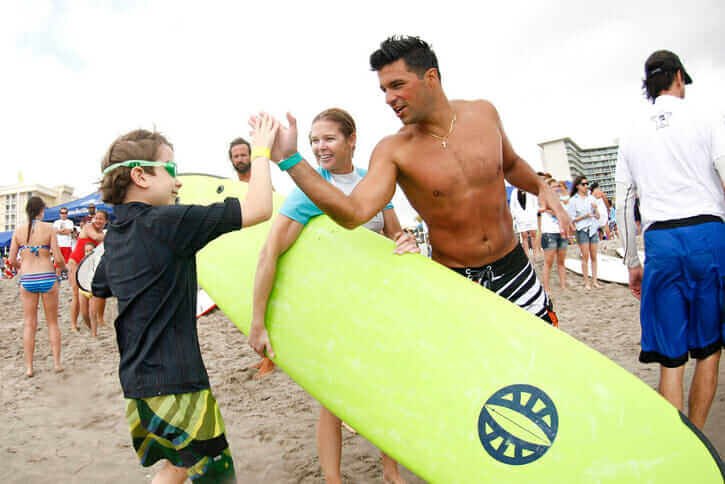There’s a growing trend that’s been sweeping the United States in recent years—a new form of therapy for children with autism.
It’s surfing, and there’s no co-pay required.
On both of America’s coasts, organizations and programs have independently formed with one purpose: to help children with autism feel the healing powers of the sea by surfing.
When one of those organizations, Surfers for Autism, put on their inaugural event in Deerfield Beach, Florida in 2007, about 40 participants and their families arrived at the beach, welcomed by friendly volunteers as surfboards laid neatly in the sand and a small swell rolled in.
The healing began during the first surf session as some, previously diagnosed as “nonverbal”, cheered and raised their hands at their accomplishment as they neared the shoreline. Those not receptive to touch were holding hands with the volunteer surf instructors as they waded into the sea. Participants were smiling from ear to ear.
Over a decade later, the healing shows no signs of slowing down. The organization now puts on 10–13 surf events for children with autism across the state of Florida on an annual basis. A few of their incredible stories also appear in my new book Waves of Healing: How Surfing Changes the Lives of Children with Autism.
And the healing isn’t exclusive to the participants. Here’s how waves of healing can wash over other people as well:
Surfing is therapeutic for those with autism. Talk to any parent after taking their child surfing, and they’ll provide a myriad of answers as to why surfing is therapeutic for their child. This can range from their child experiencing calming effects, being more focused, joyful, making sounds/speaking and more.
Interestingly, there’s science behind why this happens. Scientist Wallace J. Nichols writes that, “The water is stimulating visually, which fulfills some children’s sensory needs”; water provides “a safe and supported environment” that surrounds the body with “hydrostatic pressure” that “sooths and calms” (as another expert said, it feels like the “ultimate hug”).
Learning new motor skills like swimming, surfing or paddle-boarding can have “a broad-ranging impact on the nervous system,” according to William Greenough at the Beckman Institute at the University of Illinois. “There’s increased blood flow to crucial neurons, and the reshaping of abnormal structures in the front brain,” he explains. “But beyond that, surfing may be a vehicle to an emotional breakthrough, a way of reaching under the mask and perhaps connecting to kids like these.”
Trying to balance and ride waves also provides them with a clear focus and keeps them in the present moment. Neurobiologist Peter Vanderklish believes that the beauty of surfing “turns the focus of these kids inside out. They’re pulled out of themselves by having to live in the moment, and all their anxieties push aside.” (Nichols, Wallace J. Blue Mind: The Surprising Science That Shows How Being Near, In, On, or under Water Can Make You Happier, Healthier, More Connected, and Better at What You Do. 175. Print.)
Surfing is therapeutic for parents. Not only can parents experience unbridled enthusiasm and joy watching their son or daughter accomplish the feat of standing on a surfboard while streaking down a wave. When families gather to take their children surfing, bonds are instantly formed. Parents will remark that, before attending surf events, they didn’t have any friends who could understand their struggles. Thanks to surfing, they become part of a strong community with whom they can not only spend time, but also vent to and glean advice from.
“These are people I can call and tell them anything,” one mother said. “They get it. They don’t judge. There’s very little personal time with autism. We just don’t have the opportunity to have that in our lives, honestly. For me, that’s why I look forward to surf events—because of the family aspect of it.”
Surfing is therapeutic for siblings. As with parents, siblings experience unique challenges having a brother or sister with autism. Thanks to surfing, they have people they can relate to and form bonds with.
Surfing is therapeutic for volunteers. Spend a day, or even just an hour helping others and you’re bound to experience some incredible stories. Many people who first volunteered by helping push participants into waves found the experience so impactful that they later pursued schooling and careers in the same field.
One of Surfers for Autism’s founders summed up the entire experience best by saying ,“One of the things we did not foresee when we started this was how it would affect more than just the participants that surf. Friendships are made, siblings can hang out together and share feelings. Parents have someone else to talk to that understands. Volunteers have life-changing experiences. Isn’t that the whole point?”
For more on Surfers for Autism and the incredible stories to be found as children with autism experience the wonders of therapeutic surfing for the first time, check out Waves of Healing: How Surfing Changes the Lives of Children With Autism by Cash Lambert.
Cash Lambert is the former editor of Hawaii’s Freesurf Magazine. He has written for ESPN Outdoors, the Outdoor Channel, Autism Parenting Magazine, Surfing Magazine, Eastern Surf Magazine and Surfline. A graduate of Palm Beach Atlantic University, he served as a volunteer surf instructor with Surfers for Autism for 4 years.






